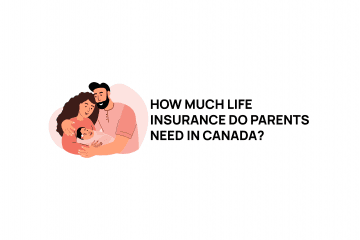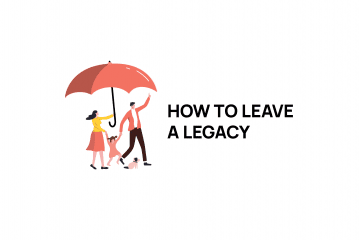
How Much Life Insurance Do I Need?
Let’s start by addressing the biggest issue with life insurance. The thought of yourself or a loved one dying is really unpleasant. Now imagine that someone is sitting at your kitchen table with you and going through a worksheet where they put some numbers into it and it spits out an ‘amount’ that you would be worth if you died. That takes the unpleasantness to the next level. After many years going through this with clients, trust me, no one likes to talk about what happens if they die unexpectedly.
As unpleasant as that process sounds, it is important to think about because the alternative is thinking about your loved ones potentially being left in difficult or even dire financial circumstances. Add the idea of your family having to move because they can’t afford your house, kids unable to go to college or university because they cannot pay for it or your partner back at work a week after your death because they need their next pay cheque. These thoughts should trump the unpleasant idea that you die unexpectedly.
Imagine what happens to your family if you are not here today. Now, how much insurance do you need? Will a GoFundMe page set up after your death cover it?
The reality is that you need to plan based on what if something happened to you today. What do you want your beneficiaries to be able to pay for immediately and how long will they need help financially to adjust to life without your income and support.
If you own a home the biggest monthly expense most people have is their mortgage payment. This is typically where you start. What debts would you want people to be able to pay off immediately? Mortgages, credit lines, credit cards, etc. These are the hard numbers and they are usually easier to arrive at. The more difficult the amount to arrive at is figuring out any extra money you want to leave behind. You can include a lump sum of money to supplement income for a few years or to help with paying for future expenses (i.e. post-secondary tuitions).
You also want to take into account the income that is lost due to death. If your family is relying on your income to cover household expenses and provide for the family, you will want to determine how long you need your income replaced for and how much of it.
Once you have determined how much coverage you require, you need to figure out if they are temporary or permanent life insurance needs. A mortgage is a great example of a temporary need. The amount of your current mortgage balance will be lower in 10 years than it is today. Structure your coverage accordingly… Use term life insurance to cover any large amounts that are temporary and consider permanent life insurance if you have an expense that is not going to go away (e.g. funeral costs, taxes at death, etc.).
The bottom line with figuring out how much you need is that I have never had a beneficiary tell me that they would take the money instead of having another day with the person who died. I have also seen the effects that good versus poor planning of how much coverage is enough can have. Put aside the unpleasantness and make the decision that gives your beneficiaries what they need right now.
In everyone’s self-image they live until they are a ripe old age and die peacefully in their sleep after living the fullest life they could ever imagine. This isn’t how the world works though and it’s always best to be prepared.
Calculating How Much Life Insurance You Need
There are several easy formulas you can use to estimate the amount of life insurance you need. Your coverage amount will help any of your dependents sustain the lifestyle you provided prior to your death. Therefore, there are a couple of key elements that will influence the total amount of recommended insurance:
- The number and age of your dependents. A “dependent” is any person who depends on you financially, but usually refers to children. The younger your children, the more they will need your income for school fees, clothing, and pretty well everything else. Your coverage amount should be enough to sustain your children through to legal adulthood (or beyond should they require longterm care). The more dependents, the higher the coverage amount.
- Property ownership debts. Any debts associated with property will increase your coverage amount. The bigger the unpaid debt, the larger your coverage amount.
- 3 Life Insurance Rules of Thumb
Now that we’ve established which factors to consider when estimating your coverage, let’s take a look at the calculations themselves.
- Multiplying your salary by 10.
This is a classic formula and you’ve probably heard it before. However, this method is a little reductive. For instance, the lack of nuance in the formula fails to take the number of dependents into consideration.
So, while multiplying your salary by 10 might be just right for a couple with a young teen, the same couple earning the same amount while raising toddler twins could struggle to make ends meet. Similarly, this calculation fails to account for any debts you have, or any assets you’ve secured.
- Multiply your salary by 10 and add for each dependent.
This option is a little more nuanced. As well as multiplying your salary, you add a lump sum of approximately $100 000 for each one of your dependent children. This guarantees that your children will still be able to afford college fees and living expenses until they can find their footing.
Of course, this method also has its limitations. For instance, it doesn’t account for dependents who require continuous care or any assets you may hold.
- DIME method.
The DIME method is pretty solid. It takes several aspects of your financial life into consideration to give a more tailored view of your ideal coverage. Here are the four figures to have on hand:
- Debts: List the value of all your outstanding debts (except for your mortgage — that comes later). You should also add an estimate of your final expenses. Remember, conventional funerals range anywhere from $5000 to $15 000.
- Income (Lost Income): First, estimate how many years your family would require your continued financial support. Multiply your current income by that number and you will get your lost income.
- Mortgage(s): Factor in the amount of money remaining on your mortgage.
- Education/Cost of Living for your dependents: This is where you add your own tally of how much each of your dependents will need for school and college.
By following this calculation and adding all the above figures together, you will have a much more comprehensive idea of how much life insurance you need. The only thing missing from the DIME method is your existing assets.
Get a free quote
Sample Calculation
Let’s play around with some real numbers to see how you might go about building your own formula.
A couple with two children aged 12 and 14 are looking for a 20 year term life insurance policy. Parent A works full time and earns a salary of $60 000/year. Parent B provides full-time childcare and works a part time for $25 000/year. The couple owes approximately $100 000 on their mortgage as well as $8000 in car payments.
As for their assets, the two have started an investment account with a current balance of $10 000 and have set aside $5 000 for each of their children’s college funds.
Here’s a breakdown of how much coverage each of these parents should look for:
Parent A
First, we add the following:
- Lost income replacement: The income replacement should be enough to make sure both children have enough funding to finish high school. This means Parent A will multiply her salary by the number of years before the youngest child graduates. $80 000 x 6 = 480 000.
- Education: Next, we want to set aside equal amounts for each child’s further education. Let’s say $100 000 each for a total of $200 000.
- Debts: This includes mortgage and auto payments for a total of $108 000.
- Final expenses: Not one for extravagant funerals, Parent A estimates her final expenses to be $5000.
Total so far = 793 000.
Next, we subtract:
- Savings: If we add the investment account and the existing college funds, we get $20 000.
Total: $793 000 – $20 000 = $773 000
Parent B
First, we add:
- Lost child care replacement: Although both children are older, Parent B still wants to be sure they would have excellent care in his absence. Let’s say, $50 000.
- Lost Income replacement: This time, we multiply $25 000 x 6 = $150 000.
- Education: Parent B also sets aside $200 000 total for college expenses.
- Debts: Once again, $108 000 in outstanding mortgage and auto payments.
- Final Expenses: Parent B is slightly pickier about his final expenses and estimates an $8 000 budget.
Total so far: 516 000.
And we subtract:
- Savings: The assets here are $20 000 also.
Total: $516 000 – $20 000 = $496 000
So, Parent A should be shopping for insurance coverage of $773 000 or higher, while Parent B’s coverage should be approximately $500 000.
Pro Tips for Buying Life Insurance:
- Give yourself some excess. Although we hope never to use it, life insurance is there to help protect your family. This means that is is always better to purchase more than you think necessary. So, while Parent A may be satisfied with a coverage amount of $775 000, she would do well to purchase a policy closer to $1M.
- Consider your options. First time buyers might be immediately drawn to term life insurance, while others may be convinced that permanent insurance is for them. Even within these categories, there are countless different products. Do you want individual or joint policies? Traditional whole life or universal coverage? Medical or no medical? Make sure you have contacted a well respected advisor to help you settle on a contract.
FAQs
Can I change my coverage amount?
It depends. Term policies tend to be less flexible when it comes to altering your coverage amount, which means you may have to cancel your policy and purchase a new one. Talk through adjustments with your current or intended provider to find your best option.
Can I purchase life insurance for my children?
Yes. If you want to insure your children’s lives, there are a range of options on the market. You can either add a rider to your own life insurance to cover your children, or purchase a stand-alone policy.
Does everyone need life insurance?
No. If you don’t have any financial dependents, you don’t need life insurance.
Can I get life insurance through my employer?
Yes, some employers do offer group life insurance policies to their employees. If you have a life insurance policy through work, make sure you list it as an asset in your calculations.
Which are more popular, single or joint policies?
Single life insurance policies are more popular that joint ones. This is because a joint policy only results in a single payout even if there is more than one death, whereas single policies offer a payout for each individual. However, it’s worth nothing that joint policies are generally less expensive.
Please contact us if you have any additional questions or request a quote on our website.




